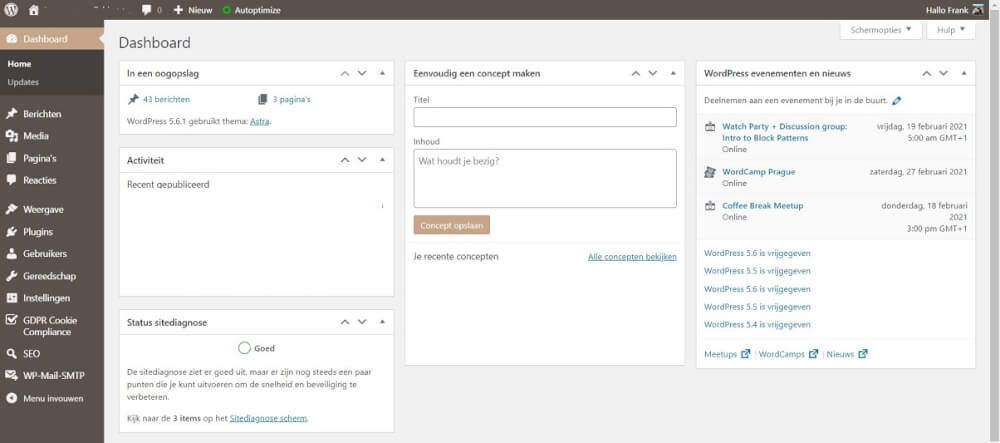Introduction WordPress dashboard
The WordPress content management system can be easily and quickly worked with by anyone. However, an introduction to this is a fine start for anyone just starting out after installing WordPress. Let's start with the introduction to the WordPress dashboard!
After installing WordPress you can log in by putting /admin behind the domain name. This will take you straight to the dashboard. In this dashboard you will see a lot of things that you can use to get started with your WordPress hosting. From the WordPress dashboard you can create your first blog post, start working with pages and get insight into comments or messages left by users. Let's cover the first steps from the WordPress dashboard below.
Create your first blog post
WordPress has been and will continue to be at the forefront of a way to blog on the Internet. WordPress makes it easy for anyone to start a blog. With the new text editor within WordPress it is easy for anyone with even a little experience with Microsoft Word, for example. To publish blog posts.
With the first blog post you can probably make an introduction to your website, but this will be read by few people. The first blog post can also be a direct response to the topics you have in mind to write about. A blog post should be at least around 500 words, less than that has little chance of ranking on search engines. And blog posts under 250 words can also be seen as thin content. This is advisable to keep in mind for every blog post you are going to write. And you can write more than 250 words on every conceivable subject. The trick is to divide it into several headings. So that you can write longer pieces many times easier.
To create your first blog post in WordPress, press the button for this and then browse through the options at your leisure. Anyone who has worked with Microsoft Word will already see a lot of familiar symbols and terms. Use headings to further subdivide the text in a logical way. And use links to link to separate pages within your own WordPress site. Or to link to external sources. Furthermore, in the media library you can see all your images, and the other media you can upload within the website.
Choosing a theme for your WordPress site
Choosing a theme is an important one within WordPress. After all, this is the foundation of your website, and should be stable, fast and secure. With regular updates and a larger user base. Therefore, read reviews and check the development log for further information on how the theme is maintained. Although it has been made easy within WordPress to switch between a theme, after a year of working on your WordPress site, you will not be so quick to switch to another theme. Since you have already put a lot of work into this at that stage.
So pay attention to which theme best suits your needs for the WordPress website, and do not make the choice in a hurry.
Plugins within WordPress
Plugins within WordPress are a good way to add extra functionality to a website. However, it is important that you do your homework on them in the same way as you do on a theme. The wrong WordPress plugin can cause your website to be hacked or susceptible to hacking.
So always limit the number of plugins you have installed, and think about how you can achieve things without an extra plugin. For example by building up a small knowledge of basic HTML. Things like creating quick links within an article can then just be done manually. Instead of using an additional plugin.
Other settings that can be used
The other settings within WordPress are a lot, too many to cover in 1 article. We recommend looking in the previous blog posts and in our knowledge base for this. We have covered this a lot before. In any case, make sure you change your URLs to pretty permalinks. In other words readable URLs instead of a random string for each page. This helps tremendously with being found on search engines like Google, Bing and DuckDuckGo.
Do you have any questions that you would like to see addressed in an article? Please contact us. Make your WordPress websitehosting a success together with MijnHostingPartner.nl!
